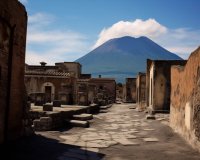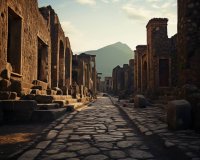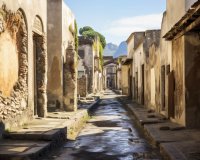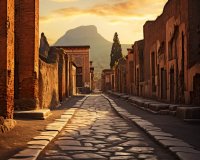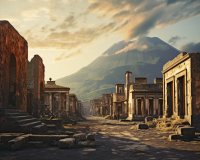Neapolitan Heritage: Discovering Pompeii and Herculaneum
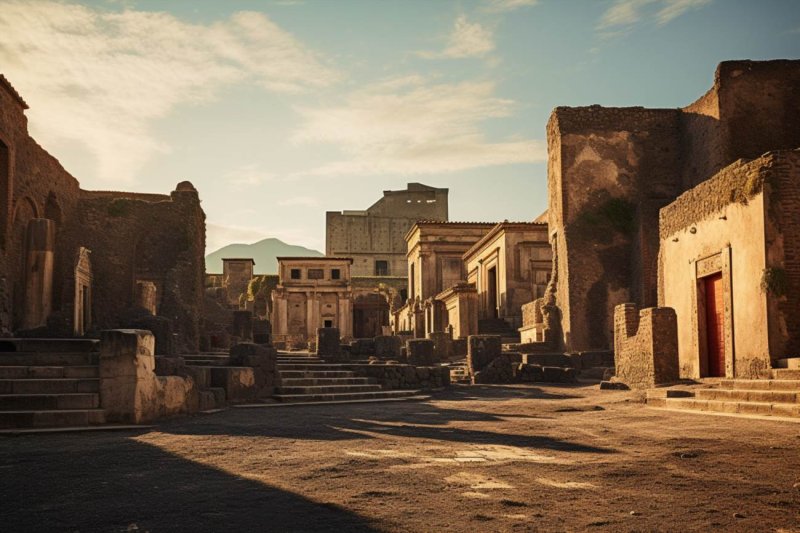
Neapolitan Heritage: Discovering Pompeii and Herculaneum
Welcome to a journey through time and history as we delve into the Neapolitan heritage of Pompeii and Herculaneum. These two ancient Roman cities have captured the imagination of travelers and historians alike for centuries, offering a unique glimpse into the past.
Imagine walking through streets frozen in time, where the daily lives of ancient Romans are preserved in remarkable detail. Pompeii and Herculaneum, both tragically destroyed by the eruption of Mount Vesuvius in 79 AD, have been remarkably preserved under layers of volcanic ash and pumice.
Let's explore these archaeological treasures and the fascinating stories they tell.
Pompeii: A City Unearthed
Pompeii, located near modern-day Naples, was a bustling city in ancient Rome. The eruption of Mount Vesuvius buried it under a thick layer of volcanic debris, preserving its buildings, art, and even its residents for almost two millennia. When the city was rediscovered in the 18th century, it provided a unique time capsule of ancient Roman life.
The city is renowned for its well-preserved architecture, including grand villas, intricate frescoes, and even a well-preserved amphitheater. Visitors can wander through its ancient streets, marvel at the preserved artifacts, and catch glimpses of life as it was in the first century AD.
| Highlights of Pompeii: |
| 1. The House of the Faun - A grand villa with a famous mosaic of a dancing faun. |
| 2. The Forum - The heart of Pompeii, where political, economic, and social activities took place. |
| 3. The Lupanar - An ancient brothel with explicit frescoes that offer unique insights into daily life. |
Herculaneum: A Glimpse into Luxury
Herculaneum, located just a few miles from Pompeii, was another victim of Vesuvius' fury. This smaller but equally captivating town was known for its opulent villas, seaside location, and wealthy inhabitants. When the site was excavated, it revealed a different aspect of Roman life, emphasizing luxury and leisure.
The villas of Herculaneum boast stunning mosaics, intricate marble work, and well-preserved wooden furniture. It's here that you can truly grasp the wealth and sophistication of the Roman elite. Don't miss the ancient beachfront, which provides a unique perspective on Roman leisure activities.
| Highlights of Herculaneum: |
| 1. The House of Neptune and Amphitrite - A villa showcasing breathtaking mosaics and frescoes. |
| 2. The Boat Sheds - A series of boat houses that once lined the ancient shoreline. |
| 3. The Herculaneum Beach - A fascinating glimpse into Roman seaside life. |
The Tragic Eruption of Vesuvius
The eruption of Mount Vesuvius in 79 AD was a cataclysmic event that had a profound impact on the region. The volcanic ash and pyroclastic flows that engulfed Pompeii and Herculaneum preserved these cities but also took the lives of thousands of people. The disaster serves as a stark reminder of the power and unpredictability of nature.
Today, both Pompeii and Herculaneum stand as poignant memorials to the tragedy that unfolded nearly two millennia ago. They allow us to honor and remember the lives lost while marveling at the enduring legacy of Roman civilization.
Visiting Pompeii and Herculaneum
If you plan to visit these incredible archaeological sites, here are some practical tips:
- Both Pompeii and Herculaneum are easily accessible from Naples, making them perfect day trip destinations.
- Consider hiring a local guide to get the most out of your visit. They can provide historical context and insights you might otherwise miss.
- Wear comfortable walking shoes, as you'll be exploring extensive ruins and cobbled streets.
- Respect the sites by not touching or defacing the ancient structures and artifacts.
Exploring the Neapolitan heritage of Pompeii and Herculaneum is a remarkable journey through time. These archaeological treasures provide an unparalleled window into the lives of ancient Romans and the impact of natural disasters. Whether you're a history enthusiast, an art lover, or simply a curious traveler, these sites are a must-visit for anyone seeking to connect with the past.
Explore Ancient Pompeii on a Half-Day Guided Tour
Discover the fascinating ruins of Pompeii with our half-day guided excursion by air-conditioned van. With skip-the-line tickets, explore the incredibly well-preserved buildings and streets of this ancient Roman town buried under volcanic ash.
Highlights
- Guided tour of Pompeii, one of the world’s most popular archaeological sites
- See well-preserved buildings, markets, thermal baths, and more
- Choose a departure from Naples or Sorrento, with convenient round-trip transfers
Experience Pompeii’s Rich History
Embark on a journey through time as you explore Pompeii's archaeological site. Skip the lines and follow your expert guide to iconic spots such as the Forum, thermal baths, the House of the Vettii, and the Lupanar – a famous brothel. Learn about the town's origins in the 8th century B.C., its flourishing period as a resort for Rome’s elite, and the tragic eruption of Mount Vesuvius that buried it.
Immerse Yourself in Ancient Life
Witness the remnants of factories, shops, taverns, cafés, and bathhouses where ancient Romans once lived their daily lives. Visit the 20,000-seat arena and open-air marketplaces, gaining insight into the bustling activity that characterized this vibrant town.
Convenient Travel Options
Choose a departure point from either Naples or Sorrento and travel comfortably in an air-conditioned vehicle. Pickup is available from designated points, ensuring a hassle-free experience.
Customer Reviews
Rated 4.5 out of 5 based on 1253 reviews, our customers appreciate the informative and engaging guided tour of Pompeii. Our experienced guides bring history to life, making this excursion a must-visit for history enthusiasts and curious travelers alike.
Book Your Spot Today
Secure your place on this unforgettable journey through ancient Pompeii. Reserve your spot now, and pay nothing today. Our flexible booking options ensure you can plan your travel with ease.
Inclusions:
- Hotel pickup and drop-off (if option selected)
- Live guide providing insightful commentary
- Skip-the-line admission ticket for Pompeii
- Guided walking tour within the archaeological site
- Comfortable transportation in an air-conditioned vehicle
Exclusions:
- Food and drinks
- Not suitable for wheelchair users
Languages: French, English, Spanish, Italian, German, Portuguese, Chinese
Meeting Points
Meeting points vary depending on the option booked:
- From Naples: Central Train Station Pickup
- From Pompeii: Tours available from Naples Train Station and Cruise Port
- From Sorrento: Tours available with Cruise Port Pickup
Price: Starting from $67.52 per person
Note: Reviews from our customers highlight the excellent guides and the immersive experience. Some visitors recommend taking the train due to traffic considerations. Book now and delve into the fascinating history of Pompeii!
The History of the Lost City: Pompeii
Pompeii, a once-thriving Roman city, holds a unique place in history due to its tragic yet fascinating story. This ancient city, located near modern Naples in Italy, was buried beneath a thick layer of volcanic ash and pumice when Mount Vesuvius erupted in 79 AD. This event not only destroyed Pompeii but also preserved it in time, making it one of the most well-preserved ancient cities ever discovered.
Archaeological excavations have unveiled a wealth of information about daily life, culture, and architecture in the Roman Empire. Let's delve into the captivating history of the lost city of Pompeii.
Foundation and Early History
Pompeii was founded around the 7th or 6th century BC by the Oscan people, an Italic group. It was later conquered and influenced by the Greeks and Etruscans. By the 2nd century BC, it became a bustling Roman city, thanks to its strategic location as a port town and a gateway to southern Italy.
Over the years, Pompeii flourished, and its population grew. The city was characterized by its well-planned streets, impressive public buildings, and lavish villas, making it a testament to Roman urban planning and architecture.
Daily Life in Pompeii
One of the most remarkable aspects of Pompeii's history is the glimpse it provides into the daily lives of its inhabitants. The well-preserved ruins reveal details about everything from their homes and clothing to their cuisine and social structure.
The city's inhabitants enjoyed a prosperous lifestyle, with amenities like public baths, theaters, and markets. Frescoes and mosaics decorated their homes, showcasing their artistic and aesthetic tastes. The forum served as the political and economic center of Pompeii, while the amphitheater hosted gladiator games and other spectacles.
With an abundance of food and wine, Pompeii's residents relished their culinary traditions. The well-preserved carbonized bread and the remnants of a fast-food restaurant are just some examples of what archaeologists have uncovered.
The Eruption of Mount Vesuvius
In the late summer of 79 AD, Mount Vesuvius suddenly erupted, sending a towering column of ash, pumice, and volcanic gas into the sky. The eruption was so powerful that it caused the top of the mountain to collapse, creating a massive pyroclastic surge that swept over Pompeii and neighboring towns.
The inhabitants of Pompeii were caught completely off guard. Some attempted to escape, while others sought shelter in their homes. Tragically, the rapidly falling ash and pumice buried the city, preserving it but also sealing the fate of its residents.
Rediscovery and Archaeological Excavations
For centuries, Pompeii remained buried and forgotten, its existence fading into the annals of history. It wasn't until the 18th century that the city's ruins were rediscovered during excavations in the area. Since then, extensive archaeological work has been carried out, revealing the city's secrets piece by piece.
Archaeologists and historians have unearthed well-preserved buildings, artifacts, and even plaster casts of the residents who perished in the disaster. These casts provide haunting yet invaluable insights into the final moments of the city's inhabitants.
Legacy and UNESCO World Heritage Site
Pompeii's excavation has not only deepened our understanding of ancient Rome but has also turned the city into a major tourist destination. Millions of visitors from around the world come to explore its streets and buildings, making it an essential part of Italy's cultural heritage.
In 1997, Pompeii, along with the nearby archaeological sites of Herculaneum and Torre Annunziata, was designated a UNESCO World Heritage Site, ensuring its protection and preservation for future generations.
Conclusion
The history of Pompeii is a testament to the dual forces of destruction and preservation. While the eruption of Mount Vesuvius brought tragedy to the city's inhabitants, it also bestowed upon us a unique window into the past. Pompeii's archaeological riches continue to unveil the secrets of an ancient civilization, and its story will forever captivate the imagination of those who explore its streets and ruins.
Private Transfer from Naples to Positano with a Pompeii Stop
Discover the beauty of the Amalfi Coast with a relaxing private transfer from Naples to Positano, including a stop in Pompeii. Your English-speaking driver, fluent in multiple languages, will ensure a stress-free journey, providing full assistance throughout the trip.
Your adventure begins with pickup from Naples, whether you're arriving at the airport, train station, or the city center. The driver will be easily recognizable, holding a sign with your name for airport or train station arrivals, and accommodating your preferred location for city center pickups.
During your journey, enjoy a 2-hour stop in Pompeii for a self-guided exploration of the archaeological site (please note that a guide is not included). After booking, you'll be contacted within 12 hours to confirm all the details of your reservation, including pick-up time, drop-off address, and flight information if applicable.
Your private transfer includes a comfortable car or minivan, depending on the number of passengers. Expect amenities like air conditioning, Wi-Fi, gasoline, driver services, motorway fees, parking fees, and city taxes. Vehicle examples range from a Fiat Tipo Station Wagon to a BMW X3 or a Mercedes Class S and E. For larger groups, minivans such as the Mercedes Vito, Mercede Sviano, or Fiat Ulysse are available.
Experience the Amalfi Coast stress-free with this all-inclusive private transfer service, ensuring a smooth and enjoyable journey to Positano.
Includes:
- English-speaking driver
- Private car or minivan (depending on the number of passengers)
- Gasoline
- Motorway fees
- Wi-Fi
- Parking fees
- City taxes
- Air conditioning
Please note: Pompeii guide and entrance fee for the ruins are not included.
Availability and Languages
Passengers can select their preferred language for this transfer, including Ukrainian, Italian, English, French, German, Spanish, or Russian. Check availability for specific dates and times to plan your trip accordingly.
Important Information:
Before you go, please be aware that free waiting time at the airport is 60 minutes, starting from the booked pick-up time. Flight monitoring is not included, and after the initial waiting period, a supplement of €15.00 for every 15 minutes applies.
Price: From $526.47 per group of up to 8 people.
Book your spot now and pay later, giving you the flexibility to plan your journey as per your convenience.
Artifacts and Finds from Pompeii and Herculaneum
Pompeii and Herculaneum, two ancient Roman cities, have captured the imagination of people around the world due to their remarkable preservation under layers of volcanic ash from the catastrophic eruption of Mount Vesuvius in 79 AD. These archaeological sites have provided a unique glimpse into daily life in ancient Rome, thanks to the plethora of artifacts and findings that have been unearthed over centuries of excavation. Let's delve into the fascinating world of these cities frozen in time.
The Eruption of Mount Vesuvius
The story of Pompeii and Herculaneum is closely tied to the eruption of Mount Vesuvius. On August 24, 79 AD, the volcano unleashed its fury, covering both cities with volcanic ash and pyroclastic flows. This devastating event preserved buildings, objects, and even the bodies of the residents, creating a time capsule that modern archaeologists have been uncovering for centuries.
Excavations and Rediscovery
The initial rediscovery of these lost cities began in the 18th century when a well-digger in Herculaneum stumbled upon ancient artifacts. This accidental discovery set the stage for organized archaeological excavations. The work in Pompeii and Herculaneum continues to this day, and it has uncovered a wealth of historical treasures.
Art and Architecture
One of the most striking aspects of Pompeii and Herculaneum is the well-preserved art and architecture. Wall frescoes, mosaics, and statues provide insights into the aesthetics and artistic tastes of the time. The famous House of the Vettii in Pompeii, for example, is adorned with intricate frescoes depicting mythological scenes and daily life.
| Artifacts |
Description |
| Frescoes |
These vivid wall paintings offer glimpses into ancient Roman life, from portraits of individuals to scenes of leisure and daily activities. |
| Mosaics |
Elaborate floor mosaics showcase the skill of Roman craftsmen, often featuring intricate geometric patterns and mythological motifs. |
| Statues |
Marble and bronze statues provide a snapshot of the artistic styles and ideals of the time, with many representing gods, emperors, and notable figures. |
Everyday Life
The artifacts found in Pompeii and Herculaneum also shed light on the day-to-day existence of ancient Romans. Kitchens with cooking utensils, bakeries with ovens, and even fast-food stands have been discovered. These remnants offer a unique perspective on how people lived, worked, and dined in antiquity.
Personal Items
Personal possessions found in the ruins further humanize the past. Jewelry, clothing, and household items have been unearthed, giving us a glimpse into the fashion and lifestyle of the time. Items like oil lamps and pottery provide insight into the daily rituals and customs of the people.
The Tragic End
The tragic end of the inhabitants of Pompeii and Herculaneum is a poignant part of their history. The remains of victims, their postures frozen in their final moments, serve as a powerful reminder of the human toll of the eruption. These casts were made by pouring plaster into cavities left by decaying bodies, preserving their shapes for eternity.
Preservation and Conservation
Preserving the artifacts and structures of Pompeii and Herculaneum is an ongoing challenge. Exposure to the elements, pollution, and even tourism can degrade the ancient sites. Conservation efforts are crucial to protect these invaluable treasures for future generations.
Visiting Pompeii and Herculaneum
Today, Pompeii and Herculaneum are open to the public, allowing visitors to walk through ancient streets, explore well-preserved homes, and marvel at the art and artifacts. These sites offer a remarkable journey back in time, a chance to witness the splendor and tragedy of two cities forever frozen in history.
Exploring the artifacts and finds from Pompeii and Herculaneum is like stepping into a time machine, providing a window into the past that is both fascinating and humbling. These ancient cities, buried for centuries, continue to captivate and educate us about the rich tapestry of human history.


